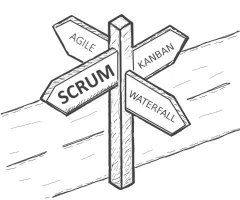Scrum
For a better understanding of the most fundamental difference between Agile and Scrum, we will use a simple parable. If we consider Agile a family, Scrum is one of its members. The latter is a subcategory of the other. Agile has multiple frameworks and Scrum is among them. Scrum is a framework built on what agile methodology brings to the table, but has some distinct characteristics itself.
The last decade was really a time of Scrum thriving. Although it started as a tool for software development, now we can find its use across multiple segments of the business. The iterative approach of Scrum helps greatly with managing complex projects while we can still address adaptive issues that we meet without having to worry about a decrease in productivity and product values.
The main idea of Scrum is to get more work done in a shorter time.
1. Specifics & roles of Scrum
Dividing the projects from the get-go into short phases called sprints is what makes Scrum effective. Each iteration contains tasks previously assigned to it, which narrows down the number of tasks to focus on and hence allows their easy prioritization ordered by the importance towards the final product. Such sprints may differ in length, although the duration should be firmly set and unchanging throughout the development. Most often we choose a one to two weeks long period, however, opt for what suits the concrete project the best.
Scrum has various roles, practices and tools that help to raise productivity. Structure gives a clear view of progression, as well as setting the milestones enables shipping in parts. Three core roles of Scrum consist of Product Owner, Scrum Master and last but not least Scrum Team.
Team members and stakeholders meet regularly so tight and two-sided cooperation is necessary. During meetings by the end of every sprint, these parties define the following steps for the upcoming phase and analyze what went well and what did not in the ending one.
The Product Owner is a person with a vision. A person that knows what to develop, and how the final product should be. Communicating this properly to the team is crucial. As he/she builds and manages the product backlog, prioritizing the order of work to be done and delivered is a part of the role. Also making sure the items in the backlog are correctly understood is important, not just with the team but also with the stakeholders. Instead of managing the progress itself, the Product Owner motivates the team to reach the envisioned goal.
The Scrum Master plays the role of facilitator. Simply put, to make the work of others easier, to enhance their efforts to do the best work possible. Hand in hand with this comes close cooperation with both the Product Owner and Scrum Team. He/she participates in defining the requirements before the project begins and subsequent sprint planning, ensuring that the product backlog is prepared for the sprint to come next. Also, it is up to him/her that every member participating in the project follows the processes.
The main focus of the Scrum Master on a daily basis once the sprint begins is organizing meetings and dealing with all the challenges and roadblocks that may arise. Altering the process is within its authority.
Instead of a manager, it is often compared to a coach. The Scrum framework encourages teams to manage their own work - the Scrum Master merely helps them do it the right way.
The Scrum Team is a unified group of five to seven individuals. Unlike usual development teams, it has no extra roles specified within itself. Every member is equal, works together, helps each other and tries to reach the same outcome. Being on the same wavelength makes the process much easier. Plan for each sprint is properly discussed with the team, upon which the amount of work that can be completed in each iteration is anticipated.
2. Scrum development cycle
Scrum follows a certain flow of steps that need to happen to fulfil its potential.
Often not counted as the events of Scrum, we should not omit to mention the foundation of the project in a form of the project charter and also the process of gathering the requirements. Based on these we further build the iterations.
As we should already see clear shapes of the product, the creation of the product backlog should come right after.
- Product backlog – is a prioritized list of required features, both new and existing that need to be changed, bug fixes, and other necessary actions to achieve a specific product outcome. The Product Owner meets with the Scrum Team to order the tasks by importance.
Outside of the preceding generalities mentioned above, Scrum has five key events, often called ceremonies: the Sprint, Sprint Planning, Daily Scrum, Sprint Review and Sprint Retrospective.
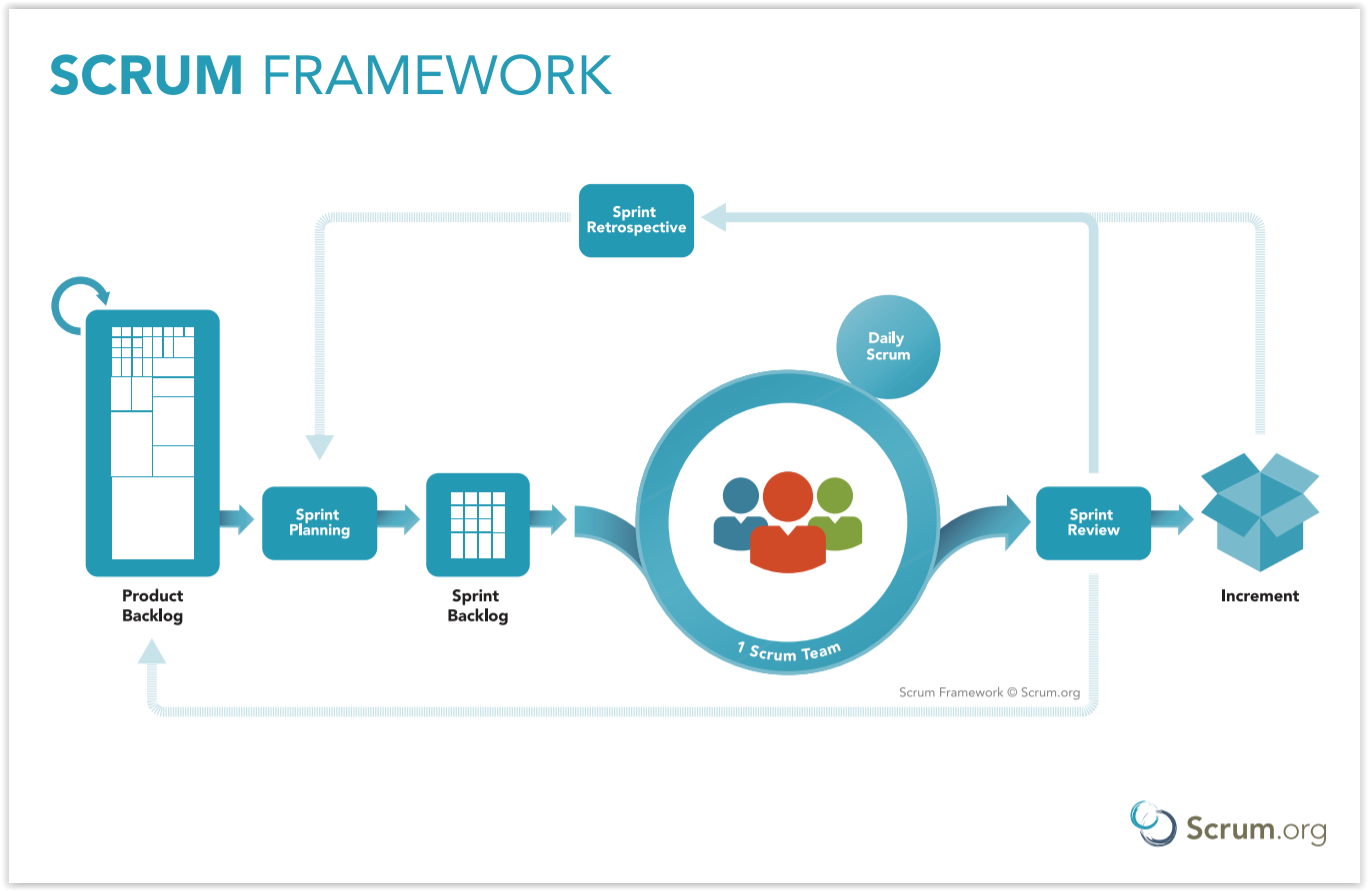
Sprint itself is more of a timed box sheltering all the remaining events happening inside of the Scrum framework. One sprint follows the other. Immediately after a sprint ends, a new one begins. During such a period, the team works through all the phases to create a meaningful part of the product. The chosen duration of sprints should stay consistent throughout the whole development process. A certain degree of predictability and limiting of risks can be achieved this way.
At the very beginning of the realization cycle stands Sprint Planning. And as the name of the event suggests, it is about planning the work to be done in a specific sprint. The Product Owner presents the items of utmost importance to the team in a planning meeting. In a joint effort, a realistically manageable Sprint Backlog is compiled - containing the tasks, also called stories, to be completed in the upcoming sprint. Setting and understanding the goal of the sprint and ways to achieve it are also crucial for such a meeting which helps the team to focus on details and the wanted outcome.
The Product Owner and the team meet at the end of each sprint to refine the backlog for the next one. Stories could be altered or newly created, already irrelevant stories may be removed, priority may be changed.
Regularity is essential for Scrum. This also applies to meetings. The event called Daily Scrum consists of short, usually 15-minute long, stand-up meetings happening each day of the sprint. Each team member summarizes accomplishments and issues of the previous day, what will be worked on today and if any potential roadblocks or risks are on the horizon. Daily Scrum not only helps to inspect the progress toward the Sprint goal but also emphasizes cooperation and adaptability.
Communication is key.
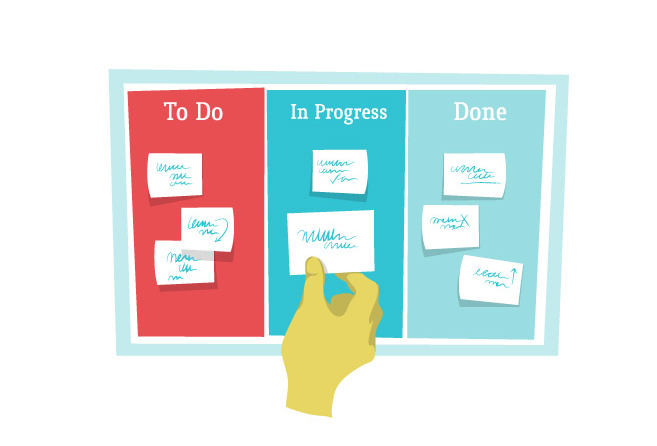
The use of visual artefacts such as task boards or charts is often used on a daily basis. Burndown chart, for example, helps the team to clearly see what’s left to be done.
Another event meeting coming by the end of each sprint is Sprint Review. A completed work done in the sprint is demonstrated by the team of developers. Not just the Product Owner, but both the Scrum Team and Stakeholders take part in this meeting. That's why it is easier to examine the finished work and state what to do next. This will serve as a foundation for the subsequent Sprint Planning.
Last but not least, the event taking place also by the end of each sprint is Sprint Retrospective. With the sole purpose of assessing what went well, what went wrong and what could be done differently, this meeting is an effective tool to reflect on how well the Scrum framework works for our team and where to improve from the next sprint on. Scrum Master is the central figure to encourage the people to get better.
With practice comes perfection. This saying applies double with Scrum.
3. Advantages of the Scrum and project types where it fits
Scrum thrives in the world of unknowns. The planning is a perfect example. As the focus is more on the present and what is being done, the long-term upfront planning is significantly limited. Such thinking within the short cycles brings value almost immediately. While the emphasis is placed on the importance of the work most needed at the moment, prioritization of tasks during each sprint phase allows us to easily address changes. Like this, the obstacles can be overcome according to customer demands or shifts in the market.
Even though we're not planning far into the future, Scrum provides a fair amount of predictability. Regular deliveries are a form of measurability of the progress, we have results in a finite timeframe. Altogether, achieving the goal incrementally helps us to stay realistic within the project boundaries. Not looking too far in the distance could be advantageous with Scrum.
The main purpose still stands in a form of better quality products. And collaboration is an essential part of achieving this. Scrum includes everyone, it leaves no one behind. All the interested parties can see the progress thanks to its transparency, regular meetings and set checkpoints. Team members know what others do, which eliminates misunderstandings and confusion. Clients are involved, consulted, and their word is being heard. Stakeholders are always in the picture of what is happening. This way the feedback is considered throughout the process, not just before the end.
If every member of the team knows and respects the rules by which the Scrum game is being played, great results could be achieved.
Summary of benefits:
- transparency, thorough team awareness,
- high adaptability, short reaction time to changes,
- reduces upfront planning,
- early deliveries,
- early and continuous feedback,
- improved quality,
- increased cost savings,
- higher team responsibility,
Suitable use:
- projects where requirements often change and evolve,
- projects where there are lots of unknowns (release date, technical description etc.)
- projects where continuous feedback is requested, management and stakeholders can easily track the progress,
- projects of medium to large size with a manageable number of people involved,
- projects where the team wants autonomy.
4. Disadvantages of the Scrum and its risks
Everything has its downsides. And despite its advantages, Scrum is no exception. The most obvious one is to properly grasp Scrum. The learning curve could seem steep at first. But with the whole team's full commitment it can be smoothly overcome. Scrum cannot be done halfway if we want to reach the success it offers. Everyone has to understand the principles, roles and responsibilities.
The more people included the riskier the use of Scrum can get. It builds on trust among each member of the team and assumes that the team will pull together with the same mindset. The team assembled at the beginning of the project should remain intact throughout the whole period. Because every member is a part of daily Scrum meetings, everyone knows everything. Therefore the amount of information is noticeable - replacing any member during the project could be problematic, as it takes time to appropriately educate another person.
Lastly, a common complication occurs often since Scrum lacks a specific completion date. While the team works on agreed deliveries, stakeholders may come up with major change requests, additional demands or even whole functionalities. Projects that looked mediocre in size at first glance take on giant proportions. One intended feature at the beginning becomes ten. Sudden or continuous, we call such event scope creep. There are multiple ways around it, such as taking precautions to prevent it from happening. Adapting constructively if it happens is also necessary.
Summary of disadvantages and risks:
- requires experience, understanding, practice,
- requires a considerable amount of commitment,
- requires properly defined tasks,
- harder to implement on projects with dozens of people,
- risky with too many changes or multiple additional features appearing (also called scope creep).
5. Scrum in practice
Agile as a whole rises in popularity, the same goes for the Scrum framework. Across multiple research done within the span of the last 5 years, Scrum is rapidly growing in its recognition. Nearing 60% of usage in practice by the respondents prefer Scrum over other methodologies.
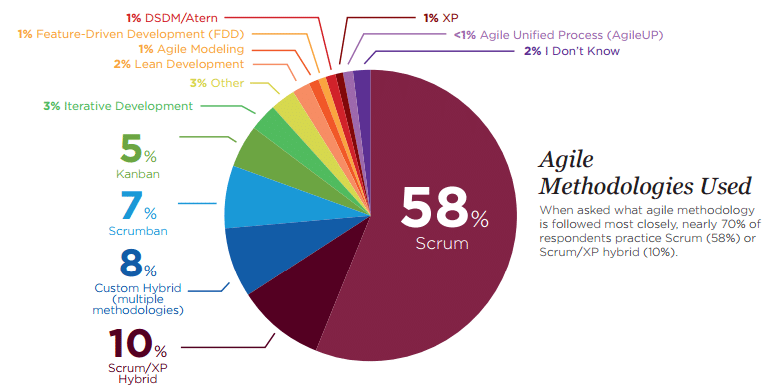
Scrum in real-life use combines a focus on three important factors. Firstly it helps the customer. Based on a study conducted by Forbes, more than half of the practitioners believe that fulfilling customer needs have the utmost priority for Scrum projects. Secondly, meeting the needs of our own business, mainly by delivering the increments within the predefined limits of scope, time and budget. And thirdly, almost 90% of the respondents claim that Scrum increases the quality of work-life for their teams. Once sticking to the necessary ceremonies, the opportunities Scrum brings are immense.
What originated to be a framework used in the software development sector can nowadays cover a multitude of areas. From finances, healthcare, and education, to the military. A wide range of areas can work very effectively with Scrum.
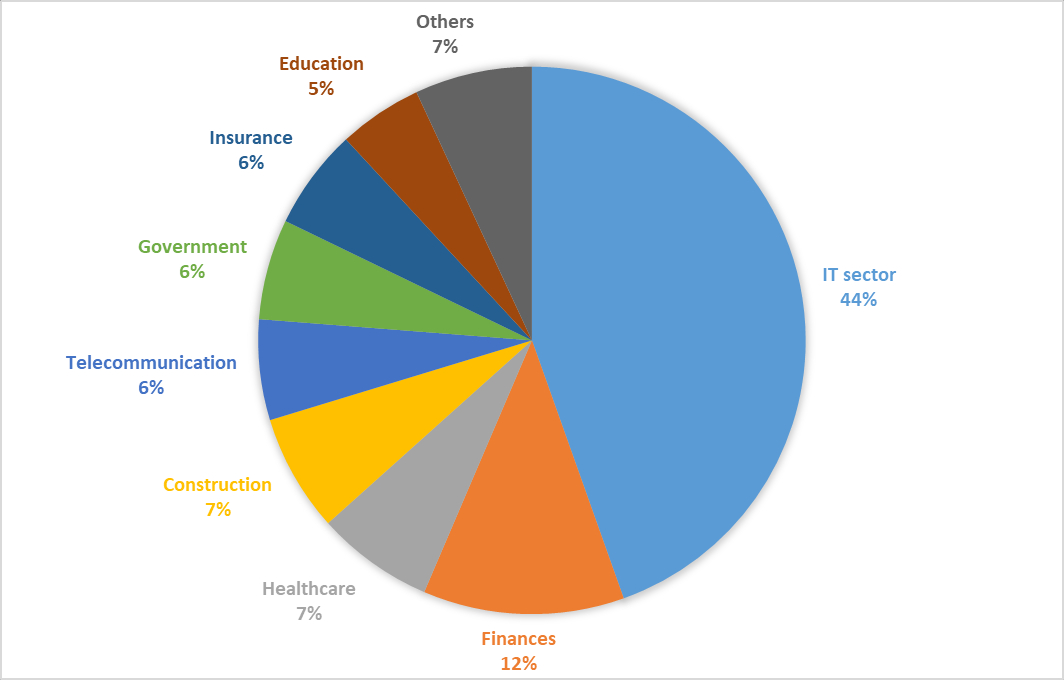
Numerous high profile, well-known organisations use the Scrum framework on a daily basis to enhance their delivery speed and the quality of their products. The most recognizable companies are the IT giants Google, Adobe, Intel and IBM. Services such as Spotify, Airbnb and even the largest entertainment media company Netflix have successfully implemented Scrum into practice. International mobile operator Vodafone, among others, utilised the methodology effectively as well.
Where it makes the most sense:
- IT sector,
- product development (for example automotive),
- financial services, insurance,
- advertising, marketing,
- healthcare,
- telecommunication,
- military, government,
- education.
6. Scrum in conclusion
Implementation of Scrum may be challenging to some. It may alter the team's habits, completely change what they are used to. Scrum can serve as an impulse - to unite the team and sync the members. Once each individual takes the responsibility and fully commits, motivation to get better grows alongside the improvement of quality and time of deliveries. Splitting the road to our goal to sprints makes them easier to realize. To fully understand the milestones is crucial. Aligning all above can bear the fruit we desire - the efficiency can be maximized, obstacles more easily overcome and all the needs of customers satisfied.
Consider Scrum more of a blueprint. There is enough place for your own adjustments. Find what suits your team and projects the best. Remember to stay realistic about the planning. Never forget to communicate. Respect the basic principles of Scrum which will help you to succeed.
So, when exactly should you reach for Scrum, or at least be interested? In case you have a large project, or more of these, with a high probability of evolving during the process of realization or more technical unknowns on how to proceed, contemplate your options. Scrum could be the solution.
In case you want to learn even more about Scrum, visit www.scrum.org.

